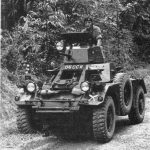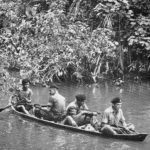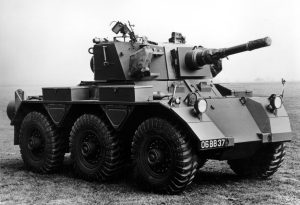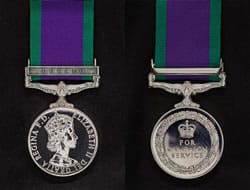Malaya and Borneo
Early in September 1962, the advance parties of The Queen’s Royal Irish Hussars left for Malaya and Singapore, and on the 9th of October, the main party arrived at Penang, again on S.S. Oxfordshire.
Early in December news came of the outbreak of the rebellion at Brunei. Within days the Queen’s Royal Irish Hussars were once again in action in a war which became known to the world as ‘Confrontation’.
In Brunei, the rebellion was fomented and led by disgruntled Malay Bruneian, Azahari. He was financed by Indonesia and there also appeared to be a direct military threat from that country.
In Sarawak the threat was different. In 1959 the Sarawak United People’s Party (SUPP) was formed. It was largely Chinese, and to combat its influence five parties, claiming to be multi-racial but largely comprising the ethnic Dyak and Malay populations, had sprung up. SUPP rapidly became infiltrated by communists, and a body known to the police and government as the Clandestine Communist Organisation (CCO) became active, particularly in the towns of Kuching, Sibu and Miri.

‘B’ Squadron QRIH Borneo 1962
As 1962 drew to a close, members of the CCO and China-born Chinese were deported from Sarawak and the CC) (an exclusively Chinese organisation) went underground.
After the rebellion in Brunei in December, it became necessary to send British troops to the Colony. It was hoped that Brunei could be induced to join Malaysia but the Sultan, mindful of his oil and its vast revenue, declined.
It was against this background that the Queen’s Royal Irish Hussars went to its (albeit undeclared) war; it was certainly active service.

Boat patrol, Sarawak
On Sunday 9th December the Queen’s Royal Irish Hussars was ordered to send a force to Brunei to assist in putting down Azahari’s rebellion, which had caught Far East Command unprepared. ‘B’ Squadron, fully equipped with armoured cars and commanded by Major Michael Wright joined the main part of the force, which consisted of 42 RM Commando, the 1st/2nd Gurkha Rifles and the Queen’s Own Highlanders.
The initial revolt in Brunei did not last long but the flames spread across the border into Indonesia. On 15th December ‘C’ Squadron, led by Major John Paley, disembarked at Kuching and was quartered in the barracks of the Sarawak Constabulary. Two troops under Lieutenants Powell and Threlfall deployed immediately on the only roads to Serian and Simangang respectively.
The outstation troops were rotated every three weeks and those based in Kuching began a programme of road patrols, roadblocks and foot and boat patrols in the jungle.
During the initial deployments in Brunei and Sarawak, another unique team from the Regiment was playing a vital part in the war. A Psychological Operations Team led by Captain David Brooks had flown to Brunei in the early stages and remained there until April 1963. Travelling and operating by air, water and land, the team was instrumental in securing the surrender of several rebels and in reassuring the jungle inhabitants that the forces of good were winning. In April and May, the team was transferred to Kuching, where again it did useful work.
On Saturday 18 April 1963 came the first long-awaited Indonesian incursion when the police station at Tebedu was attacked. That was the signal for more troops to be flown into Kuching. ‘C’ Squadron’s role changed from that of all-purpose soldiers to one of patrolling in Ferrets and carrying out roadblocks and guarding the airfield.

Saladin
At the end of the month, the Squadron moved out of the police barracks to Semengo Camp on the edge of Kuching Airport. By early July ‘C’ Squadron was back in Ipoh, with ‘B’ Squadron replacing it in Kuching and the Duke of Edinburgh’s Squadron once again moved to Singapore to take up internal security duties. ‘A’ Squadron had troops on detachment ‘over the water’ one in Brunei, where the last of the rebels were rounded up, and one in Tenom, North Borneo.
At the end of November ‘B’ Squadron Saladins were in action against targets on the Indonesian border, firing 32 rounds of HE, each cheered by an audience of enthusiastic locals and repelling the intended incursion.
In February 1964 came the final re-deployment with ‘A’ Squadron to Kuching, ‘B’ Squadron moving to Ipoh by sea and rail via Penang, and ‘C’ Squadron sailing down to Singapore from Penang.
In April 1964 ‘A’ Squadron made contact with an Indonesian patrol which had recently abandoned a road ambush position and fired some 25 rounds of Saladin 76mm ammunition as well as their machine guns. There were no Irish Hussar casualties.
The Queen’s Royal Irish Hussars had been away from Europe for three years now and it was time to come home.
For their services in Borneo, Lt Col John Strawson was awarded the OBE and three senior NCOs, SQMS J Wilmington, SQMS C Lawton and SSgt F Fox, REME, were Mentioned in Despatches.
Campaign Medal
 The General Service Medal (GSM) 1962-2007 is awarded to army, RAF, Royal Navy and Royal Marines personnel who meet the qualifying criteria for service in any of the following geographical areas:
The General Service Medal (GSM) 1962-2007 is awarded to army, RAF, Royal Navy and Royal Marines personnel who meet the qualifying criteria for service in any of the following geographical areas:
Borneo, Cyprus, Radfan, South Arabia, Malay Peninsula, Northern Ireland, Dhofar, Lebanon, Gulf, Kuwait and North Iraq/South Turkey.
Medal Clasps:
- Borneo
- Cyprus 1963-64
- Radfan
- South Arabia
- Malay Peninsula
- Northern Ireland
- Dhofar
- Lebanon
- Gulf
- Kuwait
- North Iraq and South Turkey

